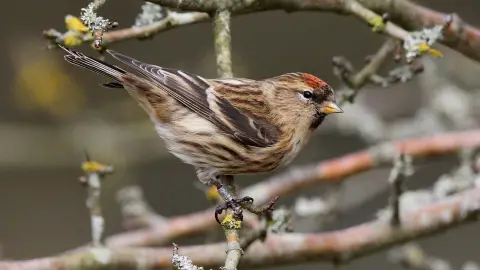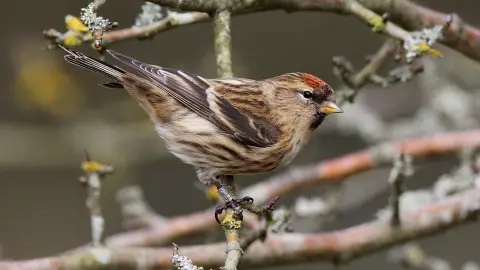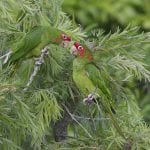Scientific Facts
| Common Name: | Lesser Redpoll |
| Scientific Name: | Acanthis cabaret |
| Life Span: | live up to 25 years |
| Size: | 11.5 centimeters |
| Habitat: | mixed woodland, birch scrub, wet woodland |
| Country of Origin: | New Zealand |
Overview

Lesser Redpolls tend to be more sociable, and they are able to mingle with any other kinds of birds. They are stripes and brown with some patches of red on their forehead and sometimes on its breast. They are used to hang upside down to feed in trees.
They are inborn to Europe and had been introduced to New Zealand. As we all know, in winter months, most birds migrate in the South. But in a mild climate, it can be found all year round in much of its range.
Physical Description
Lesser redpoll is generally relatively small, with 11.5 to 12.5 centimeters. They are stripes and brown color with some patches of red on their forehead and sometimes on its breast. They are used to hang upside down to feed in trees. Sometimes they are classified as subspecies of the common redpoll, but recently it has been ‘split’ from that species, a larger and paler species which is a winter visitor to the UK.
The breeding males have their cap bright red, and during the breeding season, they have pink breasts and face. The upperparts are brown with distinct streaking. Their wings are buff with dark stripes while their belly and under tail-coverts are whitish. There are two pale white bars on their wings. The female is similar to the male, but it lacks the pink on the breast and face, and they have lesser streaks on their wings compared to the male redpolls.
They are said to be subspecies of the common redpoll because they are similar to the lesser redpoll, but common redpoll is larger and paler with whiter underparts while the upperparts are more buff and the rump is pale with dark streaks.
Subspecies of Lesser Redpoll
- A. f. flammea- are birds that breed from South to Northern Ontario. They are an irregular visitor to Southern Canada during winter and sometimes in large numbers. The Southern Common Redpoll is striped on their sides, rump and under tail coverts while the bill is longer and less stubby than in Hoary Redpoll. Also, they are very common redpoll that is far outnumbering the rest of the subspecies.
- A. f. rostrate: They are large dark subspecies breeds on Baffin Island and also in Greenland. It is also a winter visitor like Southern Common Redpoll but in small numbers to southern parts of East from Ontario to Newfoundland. Their size is larger, and they have a thicker bill that also has darker and browner coloration than the other subspecies.
- A. h. exilipes: This subspecies breed from South to the Tundra Coast of Hudson Bay in Ontario. They usually stand out by their look with a very white frosted and rumps, while on their breast, they have lighter and less extensive pink suffusion, more lightly striped flanks, and more lightly lined to immaculate under tail coverts.
- C. h. hornemanni: They are considered the biggest and whitish of the redpolls. It breeds in Canadian High Arctic and Greenland and was considered a great rarity South of Tundra just recently.
Redpolls as Pets
Redpolls can be grouped with other types of birds, they are sociable, and they like to interact together with other birds, eat together and fly with them freely.
They are nosy birds that can easily overcome their fear from people and will eventually come and get food if they are being fed in a hand or palm of their owner. Their melody is not so loud, so it’s perfect for a person who is conscious of bird noise. They live well with others, so they are for keeps.
Native Region or Natural Habitat
These birds breed in woodland, but they also visit gardens. You may see them dangling from tiny twigs in a cane and alder trees or perhaps on shrub stems. This is an extensive breeding species in Scotland, northern and eastern England and Wales. Lesser Redpolls are lesser than common in central, southern and south-west England. Also, it does occur in these places in winter.
Behavior or Temperament
Lesser redpolls usually hunt in flocks. Mainly feed in a birch tree but may also be feed in the ground, especially during winter, where the amount of seeds is reduced. Their diet is composed of seeds, particularly small such as seeds of birch and alder trees and grasses. They can also eat fruits, buds even invertebrates. They are sociable and fond of hanging upside down in a birch tree while feeding.
Nesting and Breeding
They have interests in different types of nests, so you need to provide a wide range of nesting to let the birds choose what they like best. Anything from bamboo nests to finch boxes and even canary pots with linings in them can be obtainable. Some materials in nesting include cotton, jute, white kapok, and coconut fiber can be added to help them build their nests.
Just always remember that when locating the nests, you need to loop the chicks at around 5-6 days old so assure that you can get access in their nests. Therefore, the chicks cannot be sold when adults. Most breeders recommend that this is done late in the evening typically breeds during late winter while still light to have the best chance of not disturbing the adults with the presence of the ring.
They build their nests with a few pairs of six close together in a loose cluster. Most likely in a tree that provides a dense cover with somewhat cup-like of grass or plant stems and fine twigs. Usually, there are two families in a year with four to five eggs. The female lesser redpoll protects her eggs alone, but both parents forage the young.
Eggs
Lesser Redpolls lay 4-5 eggs, seldom up to 7. Color varies from Pale green to blue-green, with purplish to reddish-brown dots often intense at larger end. Incubation is done by female Redpoll only in about 10-11 days. The male feeds the female during incubation. The young are fed mostly by the female while the contribution by males varies. After hatching in 12 days, the young leave the nest. They fledge around 3 weeks of age.
Speech and Sounds
The collective call for a Lesser Redpoll is a harsh, metallic, staccato chuch-uch-uch-uch assumed in flight or while hovering. It also has a nostalgic alarm call. The tweeting song cartels the flight call with a buzzing rattle and is often set in a rolling song-flight around the area.
Caring the Lesser Redpoll

If you are going to provide them a cage, you should have structured it as what is shown in the picture and should have Nyjer feeder.
Many acclaims to have them housing during a flight, but these birds can survive in large cages with abundant greenery cover, and they can share good-sized flights with other redpolls during the breeding season. Optimum results can be seen in a pair per fence
Redpolls can fit with other birds from around the world. Neither species is particularly hostile.
Diet
In terms of their food, you can have specialists who mix for redpolls and other British birds that contain a good mixture of birch seed. Redpolls will also like wild seeds types of seeds that are normally eaten in the wild such as spread thistle and dandelion. Just be cautious gathering them by yourself in the wild because they spray some chemicals on them sometimes that can be dangerous for you.
Lesser Redpolls are fed in the garden by bird feeders and will eat all kinds of small seeds. Another one popular seed with Lesser Redpolls was the Niger seed, which provides the energy and exceptional tonic properties that are prominent within the bird-keeping world. Hunting on seeds in weedy grounds or small shrubs in some time and swirling away in a mass of chattering birds the next.
You can put some birch trees in your garden that would make them hang themselves on the twigs and plants that produce small seeds like spruce and alders. They are often fed among unseen branches but can be seen evidently through winter when the leaves have fallen.
And just like the other birds, Lesser Redpolls are fed on insects during the upbringing season, particularly during the summer season to add-on protein and moisture to themselves. Where it is a fine, free-flowing oil-rich seed that needs to be served from a special Niger seed feeder to get the maximum value from it.
Availability: Where to Get One?
For potential pet owners of this bird, Lesser Redpoll is for sale in pet stores, especially for birds. If not, you may check online for some sites selling this species.
Tips for Feeding Redpolls
Offer Niger Seeds
Make sure that Niger seeds are just about less than 3 months old so that it is fresh when it is put in the feeder
Hang multiple finch feeder
Redpolls are very outgoing. They can even meet in a large number of over 100. That is why having a lot of feeders will allow you to satisfy more redpolls.
Use a mesh finch feeder
It allows a lot of redpolls cling on it and eat, unlike the other finch feeders. A mesh finch feeder looks like a busy beehive when the redpolls gather.
Keep your feeders and feeding are clean
It is important to have a clean environment to prevent the birds from having diseases. You need a weak bleach solution to clean your feeders and the area around the feeders as well.
Common Disease
Redpolls get easily harmed by salmonellosis. In which salmonellosis is a cause of salmonella is a type of bacteria. And if one lesser redpoll is influenced by it, there is a possibility that all of the birds in the flock can be affected.
Treating Disease
In recognizing the Symptoms, you need to determine the following procedures.
- Observe your bird if their breathing is like in a hurry or a little bit faster than their normal breathing.
- See to it if they are quivering like having a cold.
- Monitor if they are acting like they are exhausted or if there’s an in coordination with their movements compared to their normal actions, especially when they are doing unexplainable things.
- If their feather looks like it is messed up and downcast, then it can be one of the symptoms you are usually looking for.
- Check their salivation when eating because they may show uncontrollably drooling from their mouths.
Management/ Prevention
- During the epidemic of salmonellosis, take out feeders and baths first. And afterward, maintain the cleanliness of their surroundings to prevent salmonella virus from spreading.
- Wait for summer or warmer weather to minimize the spread out because heat can kill those bacteria and viruses coming from salmonella.
- Wear gloves when you are cleaning feeders and wash hands and forearms comprehensively with soap and water to prevent these viruses from fast-spreading.
- Used cleaning materials must be thrown away to reduce the number of these salmonella viruses.
- Avoid handling sick or dead birds directly; handling sick birds can spread these viruses rapidly, so you must be cautious and must be aware to prevent these bacteria from moving faster.
Treatment is not compulsory for sick wild birds because it needs the use of antibiotics that could cause salmonellosis spreading in the bird population.
FAQ Section
What does a Redpoll look like?
Redpoll has a red patch on its forehead.
What does Redpoll eat?
They usually eat small seeds like birch, alder, and grasses.
Is a Redpoll a finch?
Redpoll is under the family of Finch.
Where do redpolls come from?
They are originally introduced in New Zealand.
Where do Redpolls live?
These birds are Northern habitats ranging from open forest to open fields.
Does Redpoll migrate?
They do migrate to the South during winter to have their food supply.
Is a Redpoll herbivore?
During their younger age, they usually eat the seed. And when summer, they eat insects.
What does Redpoll sound like?
They create vocal by means of sharp zapping notes, rising whistle sounds for half a second, and rattling for a second.



